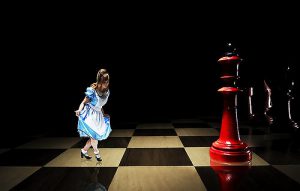 In chapter 2 of Lewis Carroll’s classic Through the Looking Glass, Alice encounters the Red Queen and the following exchange occurs after they run, with the Queen exhorting Alice to run “Faster! Faster!” even though they apparently have not gotten anywhere:
In chapter 2 of Lewis Carroll’s classic Through the Looking Glass, Alice encounters the Red Queen and the following exchange occurs after they run, with the Queen exhorting Alice to run “Faster! Faster!” even though they apparently have not gotten anywhere:
Alice: “Well in our country, you’d generally get to somewhere else—if you ran very fast for a long time as we’ve been doing.”
RQ: “A slow sort of country! Now here, you see, it takes all the running you can do to keep in the same place. If you want to get somewhere else, you must run at least twice as fast as that!”
Lewis Carroll was the pen name of Charles L. Dodgson, an English writer, poet, mathematician, logician, Anglican deacon and photographer.
The seemingly silly conversation between the Alice and the Red Queen has more depth and meaning to it than meets the eye. It spawned the “Red Queen Hypothesis,” used to describe two similar ideas that are both based on coevolution: “The original idea is that coevolution could lead to situations for which the probability of extinction is relatively constant over millions of years (Van Valen 1973). The gist of the idea is that, in tightly coevolved interactions, evolutionary change by one species (e.g., a prey or host) could lead to extinction of other species (e.g. a predator or parasite), and that the probability of such changes might be reasonably independent of species age. Van Valen named the idea “the Red Queen hypothesis,” because, under this view, species had to “run” (evolve) in order to stay in the same place (extant).”
This YouTube video explains the hypothesis and its tit-for-tat relationship to evolution:
https://www.youtube.com/watch?v=a8GMNEg6c6U
As businesses coevolve, it sometimes takes all the running they can do to keep in the same place, or survive.
Image: Alice Meets the Red Queen by clocksforseeing via Flickr CC